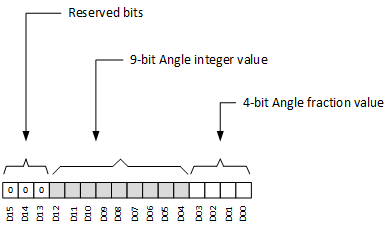SLYS035A September 2022 – September 2023 TMAG5173-Q1
PRODUCTION DATA
- 1
- 1 Features
- 2 Applications
- 3 Description
- 4 Revision History
- 5 Pin Configuration and Functions
-
6 Specifications
- 6.1 Absolute Maximum Ratings
- 6.2 ESD Ratings
- 6.3 Recommended Operating Conditions
- 6.4 Thermal Information
- 6.5 Electrical Characteristics
- 6.6 Temperature Sensor
- 6.7 Magnetic Characteristics For A1, B1, C1, D1
- 6.8 Magnetic Characteristics For A2, B2, C2, D2
- 6.9 Magnetic Temp Compensation Characteristics
- 6.10 I2C Interface Timing
- 6.11 Power up Timing
- 6.12 Timing Diagram
- 6.13 Typical Characteristics
- 7 Detailed Description
-
8 Application and Implementation
- 8.1 Application Information
- 8.2 Typical Applications
- 8.3 Best Design Practices
- 8.4 Power Supply Recommendations
- 8.5 Layout
- 9 Device and Documentation Support
- 10Mechanical, Packaging, and Orderable Information
7.5.2.3 Angle and Magnitude Data Definition
The TMAG5173-Q1 calculates the angle from a pair of magnetic axes based off the ANGLE_EN register bits setting. Figure 7-17 shows the angle information stored in the ANGLE_RESULT_MSB and ANGLE_RESULT_LSB registers. Bits D04-D12 store angle integer value from 0 to 360 degree. Bits D00-D03 store fractional angle value. The 3-MSB bits are always populated as b000. Use Equation 14 to calculate the angle value.
where
- A is the angle measured in degree.
- Di is the data bit as shown in Figure 7-17.
For example: a 354.50 degree is populated as 0001 0110 0010 1000b and a 17.25 degree is populated as 000 0001 0001 0100b.
 Figure 7-17 Angle Data Definition
Figure 7-17 Angle Data DefinitionDuring the angle calculation, use Equation 15 to calculate the resultant vector magnitude.
where
- MADCCh1, MADCCh2 are the ADC codes of the two magnetic channels selected for the angle calculation.
Figure 7-18 shows the magnitude value stored in the MAGNITUDE_RESULT register. For on-axis angular measurement the magnitude value should remain constant across the full 360° measurement.
 Figure 7-18 Magnitude Result Data
Definition
Figure 7-18 Magnitude Result Data
Definition